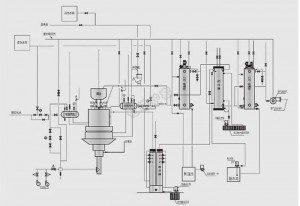A Two-Stage Coal Gasifier is a type of gasification system that converts coal or other solid fuels into a clean-burning gas that can be used for a variety of applications, such as power generation, heating, or chemical production.
The gasification process in a Two-Stage Coal Gasifier typically involves two distinct stages, each with its own reactor vessel. In the first stage, the coal is partially combusted in a lower-temperature, oxygen-starved environment, producing a mixture of gases known as syngas. The syngas is then fed into the second stage, where it undergoes further combustion and reaction in a higher temperature, oxygen-rich environment. The result is a clean-burning gas consisting of primarily hydrogen (H2) and carbon monoxide (CO), with smaller amounts of methane (CH4) and other gases.
The benefits of using a Two-Stage Coal Gasifier include higher efficiency, lower emissions, and greater flexibility compared to traditional coal-fired power plants. The gas produced by the gasifier can be used as a fuel for gas turbines or internal combustion engines, or as a feedstock for chemical production. Additionally, the gasification process can be used to capture and sequester carbon dioxide (CO2) emissions, reducing the environmental impact of coal-based energy production.
Overall, Two Stage Coal Gasifiers are a promising technology for producing clean, efficient energy from coal and other solid fuels.
Two-Stage Coal Gasifier: working principle
The working principle of a Two-Stage Coal Gasifier can be summarized in the following steps:
- Coal preparation: The coal is first crushed and dried to a specific size and moisture content to ensure efficient gasification.
- First stage gasification: The coal is partially combusted in a lower temperature, oxygen-starved environment, such as a fluidized bed reactor. This produces a mixture of gases known as syngas, which consists primarily of carbon monoxide (CO), hydrogen (H2), and smaller amounts of methane (CH4) and other gases. The first stage gasification process is typically controlled to ensure a specific temperature and residence time, which affects the composition and quality of the syngas produced.
- Gas cleaning: The syngas produced in the first stage is then cleaned to remove impurities such as sulfur compounds, tar, and particulates. This is done to prevent corrosion and fouling of downstream equipment and to meet environmental regulations.
- Second stage gasification: The cleaned syngas is then fed into the second stage, where it undergoes further combustion and reaction in a higher temperature, oxygen-rich environment, such as a fixed bed reactor. This stage is designed to convert the remaining carbon in the syngas to carbon monoxide and hydrogen, which increases the heating value and reduces emissions.
- Gas cooling and conditioning: The resulting gas is then cooled and conditioned to the desired temperature and pressure for use in downstream equipment, such as gas turbines or chemical reactors.
The overall working principle of a Two-Stage Coal Gasifier involves using a two-stage process to convert coal into a clean-burning gas that can be used for a variety of applications while minimizing emissions and environmental impact. The gasification process involves controlled combustion and reaction of coal in a specific temperature and oxygen environment to produce high-quality syngas, which are then cleaned and conditioned for use in downstream equipment.
The characteristics
However, here are some general characteristics of a typical Two Stage Coal Gasifier:
- Efficiency: It can achieve high levels of efficiency compared to traditional coal-fired power plants. The gasification process can convert up to 90% of the energy in the coal into usable gas, compared to around 40% in a conventional coal-fired power plant.
- Fuel flexibility: They are capable of gasifying a variety of solid fuels, including coal, biomass, and municipal solid waste. This makes them a versatile option for producing clean energy from a variety of sources.
- Low emissions: Two Stage Coal Gasifiers produce significantly lower emissions of particulates, sulfur dioxide (SO2), and nitrogen oxides (NOx) compared to traditional coal-fired power plants. Additionally, the gasification process can be used to capture and sequester carbon dioxide (CO2) emissions, reducing the environmental impact of coal-based energy production.
- High temperature and pressure capabilities: Two Stage Coal Gasifiers are designed to operate at high temperatures and pressures, which allows for efficient gasification and gas conditioning.
- Advanced control systems: Many Two Stage Coal Gasifiers are equipped with advanced control systems that allow for precise control of the gasification process and monitoring of gas quality and emissions. This allows operators to optimize efficiency, minimize emissions, and ensure safe operation.









